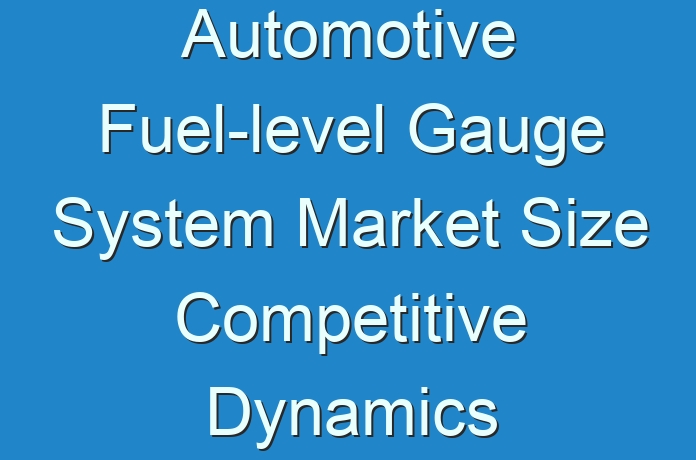
Automotive Fuel-level Gauge System Market: Introduction
- Fuel level gauge, also known as fuel level sensor, enables drivers to monitor fuel consumption and helps determine when to refill the tank. The fuel gauge consists of two main components: the sensing system, also known as the sender, and the indicator also commonly referred to as the gauge.
Key Drivers of Automotive Fuel-level Gauge System Market
- Rise in per capita income among the population coupled with increasing urbanization and a rise in the demand for transportation of the population as well as consumer products is boosting the demand for vehicles. The automotive industry has been witnessing a surge in demand for both passenger and commercial vehicles for the last decade, driven by a surge of mobility services such as ride-sharing, vehicle-leasing, and vehicle subscription services owing to the flexibility, convenience, and affordability associated in these mobility models. This, in turn, has been propelling the demand for automotive and consequently, driving the automotive fuel-level gauge systems market.
Challenges in Automotive Fuel-level Gauge System Market
- Electric vehicles are replacing conventional IC engine-run vehicles, this trend is estimated to act as a major restraint to the automotive fuel-level gauge system market. Several government organizations and regulatory authorities around the globe have enacted stringent vehicle regulations and standards pertaining to diesel engine-operated vehicles. This, in turn, has prompted automakers around the globe to announce their plans to phase out the production of diesel engine vehicles. For instance, on December 29, 2019, Mitsubishi Motors, a Japan-based automaker announced plans to eliminate diesel versions of its key car models by the end of 2024 and significantly reduce the size of its existing diesel vehicle business. Automakers are expected to shift their focus towards electric vehicles. The company plans to modify the current diesel production facilities for manufacturing electric vehicles. Additionally, in May 2018, Nissan Motors announced that they have already terminated development of diesel engines. Automakers including GM, Ford, and Volkswagen have also announced similar plans to stop diesel engine vehicle production across Europe and increase their capabilities in terms of manufacturing electric vehicles. Therefore, phasing out of IC engines is projected to act as a major restraint to the automotive fuel-level gauge systems market in the near future.
- The COVID-19 pandemic has affected national as well as international automotive supply chains, manufacturing and R&D operations, thus hampered the automotive industry. Post first wave of COVID-19 global economies have started opening up automotive manufacturing and supply chain operations. Thus, the COVID impact on the industry have seems to reach a state of normalcy; however, a resurgence in COVID-19 cases in countries across Europe has prompted governments to impose a second round of lockdown restrictions and hence, uncertainty in the automotive industry continues. A gradual recovery in the demand for automotive and ancillaries is anticipated in the next few months despite concerns around the risk of a second wave of infection in numerous countries and other geopolitical risks.
Are you a start-up willing to make it big in the business? Grab an exclusive PDF Brochure of this report https://www.transparencymarketresearch.com/sample/sample.php?flag=B&rep_id=81074

Opportunities in Automotive Fuel-level Gauge System Market
- Technological developments and better design of fuel tanks, such as elimination of bends and reduction in variation in height, which impacts sensor accuracy, to +/- 1 mm verses the industry standard +/- 3mm for fitting of sensors in the vehicle, are aiding in precise measuring of fuel levels in the automotive vehicles and consequently, boosting the adopting of fuel-level gauge systems in more vehicle classes. This, in turn, is estimated to offer significant opportunity to the market.
Automotive fuel-level gauge system market in Asia Pacific to expand at a notable growth rate
- Asia Pacific is an expanding and major market for automotive fuel-level gauge system, owing to the rapid urbanization, increase in population, industrialization, increase in per capita income, surge in economic activity, development of road and infrastructure, expansion of the construction industry, and a rise in living standards. Furthermore, expansion of the e-commerce industry coupled with rapid expansion of the road logistics network are together boosting vehicle sales, especially in rapidly expanding economies such as China and India, thus driving the automotive fuel-level gauge system market.
Key Players Operating in Automotive Fuel-level Gauge System Market
The global automotive fuel-level gauge system market is moderately consolidated. A few of the key players operating in the global automotive fuel-level gauge system market are:
- Continental AG
- BorgWarner Inc.
- elobau GmbH & Co. KG
- Minda Corp. Ltd
- Pricol Ltd
- Robert Bosch GmbH
- Rochester Gauges LLC
- TE Connectivity Ltd
- Valeo SA
- Omnicomm
For Right Perspective & Competitive Insights on Automotive Perception Sensor Market, Request for a Sample https://www.transparencymarketresearch.com/sample/sample.php?flag=S&rep_id=81074
Global Automotive Perception Sensor Market: Research Scope
Global Automotive Fuel-level Gauge System Market, by Product Type
- Capacitive
- Resistive
- Others
Global Automotive Fuel-level Gauge System Market, by Vehicle Type
- Passenger Vehicle
- Light Duty Vehicle
- Medium & Heavy Duty Truck
- Coaches & Buses
Global Automotive Fuel-level Gauge System Market, by Sales Channel
- OEM
- Aftermarket
Global Automotive Fuel-level Gauge System Market, by Region
- North America
- U.S.
- Canada
- Europe
- Germany
- France
- U.K.
- Italy
- Spain
- Nordic Region
- Rest of Europe
- Asia Pacific
- China
- Japan
- India
- ASEAN
- Rest of Asia Pacific
- Latin America
- Brazil
- Mexico
- Rest of Latin America
- Middle East & Africa
- GCC
- South Africa
- Rest of Middle East & Africa





